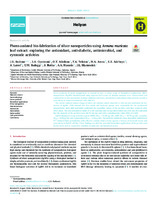Photo-assisted bio-fabrication of silver nanoparticles using Annona muricata leaf extract: exploring the antioxidant, anti-diabetic, antimicrobial, and cytotoxic activities
Abstract
Green synthesis of metal nanoparticles is reputed to have a robust range of biomedical applications. Silver nanoparticles (AgNPs) bio-fabricated using aqueous leaf extract of Annona muricata were characterized and evaluated for in-vitro antioxidant, lipid peroxidation inhibition, anti-diabetic and antimicrobial activities as well as cytotoxicity in human keratinocyte cells (HaCaT). The extract induced colour change of silver salt solution which absorbed at 420 nm and confirmed the formation of AgNPs. FTIR showed that free amide and hydroxyl groups were responsible for the synthesized nanoparticles. Both XRD and SAED confirmed the crystalline nature of the particles with face centered cubic (FCC) phase. The zeta potential revealed -27.2 mV potential and average distribution size of 35 nm. DLS indicated that the majority of the particles were 86.78 nm size and with a polydispersity index (PDI) of 0.329. AgNPs displayed strong activities against DPPH (IC50 = 51.80 μg/ml), ABTS (IC50 = 30.78 μg/ml), α-amylase (IC50 = 0.90 μg/ml) and α-glucosidase (IC50 = 3.32 μg/ml). The particles exhibited a dose-dependent inhibition of Fe2+-induced lipid peroxidation with effective antimicrobial activity against a battery of bacterial strains and cytotoxicity in HaCaT cell line. These findings revealed the potential biomedical applications of the particles and further work will be required to establish its molecular mechanism of action.

